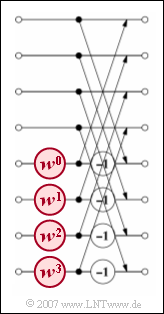Exercise 5.5Z: Complexity of the FFT
The FFT algorithm (Fast Fourier Transform) realises a Discrete Fourier Transform with the smallest possible computational effort if the parameter $N$ is a power of two. In detail, the following calculation steps are necessary to carry out an FFT:
- The FFT occurs in ${\rm log_2} \ N$ stages, whereby the exact same number of arithmetic operations must be carried out in each stage.
- The diagram shows the third and last stage for the example $N = 8$. It can be seen that $N/2$ basic operations have to be carried out in this and the other stages.
- In each basic operation, which is often called a butterfly , two complex outputs are calculated from the two complex input variables $E_1$ and $E_2$ :
- $$ A_1 = E_1 + E_2 \cdot w^{\hspace{0.04cm}\mu}, $$
- $$ A_2 = E_1 - E_2 \cdot w^{\hspace{0.04cm} \mu}\hspace{0.05cm}.$$
- Here $w = {\rm e}^{-{\rm j}\hspace{0.05cm}\cdot \hspace{0.05cm} 2\pi/N}$ denotes the complex rotation factor. For $N = 8$ the value $w = {\rm e}^{-{\rm j} \hspace{0.05cm}\cdot \hspace{0.05cm} \pi/4} = \cos(45^\circ) - {\rm j} \cdot \sin(45^\circ)\hspace{0.05cm}$ is obtained.
- The exponent $\mu$ for this complex rotation factor can take all integer values between $0$ and $N/2-1$ . For $N = 8$ it is:
- $$w^0 = 1,\hspace{0.2cm}w^1 = {1}/{\sqrt{2}}- {\rm j} \cdot{1}/{\sqrt{2}},\hspace{0.2cm}w^2 = - {\rm j},\hspace{0.2cm}w^3 = -{1}/{\sqrt{2}}- {\rm j} \cdot{1}/{\sqrt{2}} \hspace{0.05cm}.$$
The purpose of this task is to determine the number of arithmetic operations $(\mathcal{O}_{\rm FFT})$ required for the FFT and compare it with the value $\mathcal{O}_{\rm DFT} ≈ 8\cdot N^2$ that can be specified for the DFT
To be noted:
- It makes sense to calculate the powers of $w$ before the actual algorithm and store them in a lookup table.
- The operations necessary for this are therefore to be disregarded.
- The bit reversal operation – a rearrangement that has to be carried out before the first stage – is also not to be taken into account in this estimation.
Hint:
- This task belongs to the chapter Fast Fourier Transform (FFT).
Questions
Solution
- $$(R_1 + {\rm j} \cdot I_1) + (R_2 + {\rm j} \cdot I_2) = (R_1 + R_2) + {\rm j} \cdot (I_1 + I_2)\hspace{0.3cm}\Rightarrow \hspace{0.3cm} \hspace{0.15 cm}\underline{ A_{\rm A} = 2}\hspace{0.05cm}.$$
(2) Any complex multiplication requires four real multiplications and two real additions:
- $$(R_1 + {\rm j} \cdot I_1) (R_2 + {\rm j} \cdot I_2) = (R_1 \cdot R_2 - I_1 \cdot I_2) + {\rm j} \cdot (R_1 \cdot I_2 + R_2 \cdot I_1)\hspace{0.3cm} \Rightarrow \hspace{0.3cm}\hspace{0.15 cm}\underline{A_{\rm M} = 2,\hspace{0.3cm}M_{\rm M} = 4} \hspace{0.05cm}.$$
(3) The basic operations with complex inputs $E_1$, $E_2$ and $w^{\hspace{0.04cm}\mu}$ are:
- $$ A_1 = E_1 + E_2 \cdot w^{\hspace{0.04cm}\mu},\hspace{0.5cm} A_2 = E_1 - E_2 \cdot w^{\hspace{0.04cm} \mu}\hspace{0.05cm}.$$
- This means one complex multiplication and two complex additions: $\hspace{0.15 cm}\underline{a_{\rm B} = 2, \hspace{0.2cm}m_{\rm B} = 1} \hspace{0.05cm}.$
(4) In contrast to the first computers, a multiplication today does not take much more computing time than an addition or subtraction.
- Using the results of subtasks (1), (2) and (3) we obtain for the total number of arithmetic operations:
- $$ \mathcal{O}_{\rm B} = a_{\rm B}\cdot A_{\rm A} + a_{\rm B}\cdot (A_{\rm M} +M_{\rm M} ) = 2 \cdot 2 + 1 \cdot 6\hspace{0.15 cm}\underline{ = 10} \hspace{0.05cm}.$$
(5) There are ${\rm log_2} \ N$ stages in total, each of which requires $N/2$ basic operations to be performed:
- $$\mathcal{O}_{\rm FFT} = {\rm log_2}\hspace{0.1cm}N \cdot \frac{N}{2}\cdot \mathcal{O}_{\rm B} = 5 \cdot N \cdot {\rm log_2}\hspace{0.1cm}N$$
- $$\Rightarrow \hspace{0.3cm}\mathcal{O}_{\rm FFT}\hspace{0.1cm}(N=16) = 5\cdot 16 \cdot 4 \hspace{0.15 cm}\underline{= 320}, \hspace{0.5cm}\mathcal{O}_{\rm FFT}\hspace{0.1cm}(N=1024) = 5\cdot 1024 \cdot 10 \hspace{0.15 cm}\underline{= 51200} \hspace{0.05cm}.$$
(6) The computational time gain of the FFT over the conventional DFT is given by:
- $$G_{\rm FFT} = \frac{\mathcal{O}_{\rm DFT}}{\mathcal{O}_{\rm FFT}} = \frac{8 \cdot N^2} {5 \cdot N \cdot {\rm log_2}\hspace{0.1cm}N }= 1.6 \cdot \frac{N}{ {\rm log_2}\hspace{0.1cm}N}$$
- $$\Rightarrow \hspace{0.3cm}G_{\rm FFT} \hspace{0.1cm}(N=16) = 1.6 \cdot \frac{16}{ 4} \hspace{0.15 cm}\underline{= 6.4}, \hspace{0.5cm}G_{\rm FFT} \hspace{0.1cm}(N=1024) = 1.6 \cdot\frac{1024}{ 10}\hspace{0.15 cm}\underline{ \approx 164} \hspace{0.05cm}.$$
